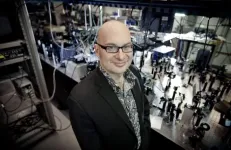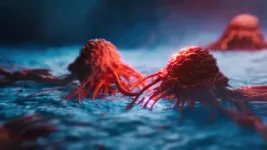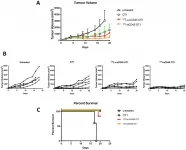Study finds Dense Breast Notification legislation has not met all desired goals
2021-01-11
(Press-News.org) (Boston)--Little previous research has examined the effects of Dense Breast Notifications (DBNs), but a new study suggests the legislatively required notifications have achieved partial success: women living in states in which in DBNs are mandated had higher rates of being informed about personal breast density and of having had breast density discussions with providers, though rates were low overall.
DBNs are a written notification to a woman after a mammogram with information about breast density. The goal is to motivate her to speak with her doctor about her personal risk and determine if supplemental screening for breast cancer is appropriate. DBNs are mandated in more than 38 states and the Food Drug Administration (FDA) is developing standardized language for a federal/nationwide notification.
Prior findings from these same researchers at Boston University School of Medicine (BUSM) showed many states' DBNs are written at a higher literacy level than women residing in that state, which suggests that some women may find it hard to understand the notifications. They have now conducted one of the first national surveys to ask women about their reactions to these notifications and to understand their knowledge, awareness and plans about breast density while examining whether these findings vary among women of varying race/ethnicity, income, and health literacy levels.
In this new study, the researchers investigated whether there were differential breast density awareness, knowledge or discussions among women residing in states with and without DBN legislation or based on sociodemographic characteristics.
Although the study did show that DBN laws are associated with more women receiving information about personal breast density and increased likelihood of having a discussion with a healthcare provider about breast density, women of color, those with lower incomes and those with lower health literacy were generally less likely to have received personal breast density information or to speak with their providers. However, while DBN laws were not generally associated with differences in women's knowledge about risks associated with breast density, Hispanic, lower income, and low health literacy women had less knowledge regarding density's tendency to mask cancers on mammograms, and were less likely to recognize the increased breast cancer risk.
"These findings suggest that 'one size does not fit all' when breast density information is conveyed and suggests that the message or the mode of dissemination may need to be tailored for different populations to achieve knowledge equity," explained corresponding author Nancy Kressin, PhD, professor of medicine at BUSM.
Given that women in DBN states were twice as likely to speak with their doctors, the researchers believe physicians seem a natural conduit for tailored discussions that meet each woman's needs. However, Kressin points out that prior studies have shown that for this approach to be most effective, further physician education will be needed.
INFORMATION:
These findings appear online in the Journal of the American College of Radiology.
Funding for this study was provided by the American Cancer Society and the National Cancer Institute.
ELSE PRESS RELEASES FROM THIS DATE:
2021-01-11
Scientists from the University of Bath have made a sustainable polymer using the second most abundant sugar in nature, xylose.
Not only does the new nature-inspired material reduce reliance on crude oil products, but its properties can also be easily controlled to make the material flexible or crystalline.
The researchers, from the University's Centre for Sustainable and Circular Technologies, report the polymer, from the polyether family, has a variety of applications, including as a building block for polyurethane, used in mattresses and shoe soles; as a bio-derived alternative to polyethylene glycol, a chemical widely used in bio-medicine; or to polyethylene oxide, ...
2021-01-11
An international team of researchers, including Professor END ...
2021-01-11
PHILADELPHIA -- (Jan. 11, 2020) -- Mutations that inactivate the ARID1A gene in ovarian cancer increase utilization of the glutamine amino acid making cancer cells dependent on glutamine metabolism, according to a study by The Wistar Institute published online in Nature Cancer. Researchers also showed that pharmacologic inhibition of glutamine metabolism may represent an effective therapeutic strategy for ARID1A-mutant ovarian cancer.
Up to 60% of ovarian clear cell carcinomas (OCCC) have inactivating mutations in the ARID1A tumor suppressor gene. These ...
2021-01-11
Oncotarget recently published "Targeted lymphodepletion with a CD45-directed antibody radioconjugate as a novel conditioning regimen prior to adoptive cell therapy" which reported that Chimeric antigen receptor T cell therapies, and adoptive cell therapy in general, represent one of the most promising anti-cancer strategies.
In contrast to relatively non-specific chemotherapy-derived lymphodepletion, targeted lymphodepletion with radioimmunotherapy directed to CD45 may be a safer and more effective alternative to target and deplete immune cells. Here the authors describe the results ...
2021-01-11
For the brain to learn, retain memories, process sensory information, and coordinate body movements, its groups of nerve cells must generate coordinated electrical signals. Disorder in synchronous firing can impair these processes and, in extreme cases, lead to seizures and epilepsy.
Synchrony between neighboring neurons depends on the protein connexin 36, an essential element of certain types of synaptic connections that, unlike classical chemical synapses, pass signals between neurons through direct electrical connections. For more than 15 years, scientists have debated the tie between connexin 36 and epilepsy.
Now, a team of Virginia Tech scientists led by Yuchin Albert Pan, an associate professor at the Fralin Biomedical Research ...
2021-01-11
Many policymakers and educational institutions hope to boost their economies by stimulating students' entrepreneurial intentions. To date, most research concluded that entrepreneurship education could increase these intentions by improving the image that students have of entrepreneurship as a career option, making them see how their environment can help them become entrepreneurs or increasing their self-confidence regarding their entrepreneurial skills. However, recent studies show that even if these goals are achieved, students' entrepreneurial intentions often ...
2021-01-11
HOUSTON - (Jan. 11, 2021) - Rice University scientists have extended their technique to produce graphene in a flash to tailor the properties of other 2D materials.
The labs of chemist James Tour and materials theorist Boris Yakobson reported in the American Chemical Society's ACS Nano they have successfully "flashed" bulk amounts of 2D dichalcogenides, changing them from semiconductors to metallics.
Such materials are valuable for electronics, catalysis and as lubricants, among other applications.
The process employs flash Joule heating -- using an electrical charge to dramatically raise the material's temperature -- to convert semiconducting molybdenum disulfide and tungsten disulfide. The duration of the pulse and select additives can also control the now-metallic products' ...
2021-01-11
DURHAM, N.C. - A Duke-led team of scientists has developed a bio-compatible surgical patch that releases non-opioid painkillers directly to the site of a wound for days and then dissolves away.
The polymer patch provides a controlled release of a drug that blocks the enzyme COX-2 (cyclooxygenase-2,) which drives pain and inflammation. The study appears Jan. 10, 2021 in the Journal of Controlled Release.
When they started "We were making hernia meshes and different antimicrobial films," said Matthew Becker, the Hugo L. Blomquist professor chemistry at Duke, and last author on the paper. "We thought you could potentially put pain drugs or anesthetics in the film if you ...
2021-01-11
A shapeshifting immune system protein called XCL1 evolved from a single-shape ancestor hundreds of millions of years ago. Now, researchers at the Medical College of Wisconsin (MCW) discovered the molecular basis for how this happened. In the process they uncovered principles that scientists can use to design purpose-built nanoscale transformers for use as biosensors, components of molecular machines, and even therapeutics. The findings were published today in Science. The primary and senior authors of the manuscript, respectively, are MCW researchers Acacia Dishman, MD-PhD student, and Brian Volkman, PhD, professor of biochemistry.
Molecular switches can be used to detect cancer, construct nanoscale machines, and even build cellular computers. ...
2021-01-11
Scientists crafting a nickel-based catalyst used in making hydrogen fuel built it one atomic layer at a time to gain full control over its chemical properties. But the finished material didn't behave as they expected: As one version of the catalyst went about its work, the top-most layer of atoms rearranged to form a new pattern, as if the square tiles that cover a floor had suddenly changed to hexagons.
But that's ok, they reported today, because understanding and controlling this surprising transformation gives them a new way to turn catalytic activity on and off and make good catalysts ...
LAST 30 PRESS RELEASES:
[Press-News.org] Study finds Dense Breast Notification legislation has not met all desired goals





